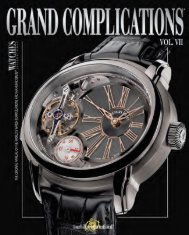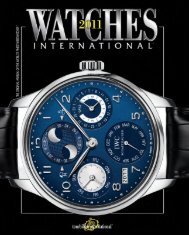180 YEARS OF
180 YEARS OF
180 YEARS OF
You also want an ePaper? Increase the reach of your titles
YUMPU automatically turns print PDFs into web optimized ePapers that Google loves.
duced in 1939. Unique to its type was the central pair of<br />
hands that could be controlled by a push-piece. Pressing<br />
the push-piece caused the horizontal clutch to open and<br />
the hands to remain in position until the push-piece was<br />
released, at which point they began to advance again immediately.<br />
e reset function required pressing down the<br />
push-piece fully. is type of mechanism required fewer<br />
components, so Longines was able to omit the costly column<br />
wheel. Moreover, its height of 5.9 to 6.1 mm was<br />
also easier to work with. Even though the manufacture<br />
used high-quality components such as a Glucydur screw<br />
balance and a self-adjusting overcoil hairspring and<br />
spared no expense in nishing, the price was still considerably<br />
less than other conventional chronographs. But<br />
sales did not achieve expected levels due to massive<br />
export restrictions during World War II.<br />
e extraordinary Siderograph was also introduced<br />
in 1939. is watch represented a complex development<br />
in the evolution of the Lindbergh Hour Angle watch used<br />
to determine exact longitude in aircra navigation in<br />
combination with a sextant. Its most striking feature was<br />
the nely detailed dial design that permitted degrees and<br />
minutes to be read in sidereal time. To accomplish this,<br />
Longines’s watchmakers adapted the hand-wound<br />
movement 37.9 to equal the duration of the average<br />
sidereal day, which is three minutes and 56.555 seconds<br />
shorter than an average solar day. e Siderograph was<br />
not designed to tell standard, civilian time (measuring<br />
exactly 86,400 seconds per day). e split-seconds jaws<br />
and column wheel were mounted on the back of the<br />
watch movement. A resetting device was essential in this<br />
case. Pressing the pusher at 4 o’clock stopped the split<br />
seconds. Pressing the pusher again allowed it to catch<br />
up and synchronize with the continuously advancing<br />
second hand.<br />
Sidereal time model<br />
“Siderograph” with<br />
double rattrapante<br />
and contacts for time<br />
signals, from ca. 1940<br />
Elapsed Time | CHRONOGRAPHS<br />
Steel model “Stop<br />
Seconde” from the<br />
1940s. Hand-wind<br />
Cal. 12.68Z Stop,<br />
diameter = 27 mm,<br />
height = 6.1 mm,<br />
central 60-minute<br />
totalizer. Production<br />
began in 1938/1939.<br />
LONGINES SPECIAL WatchTime | 47

















